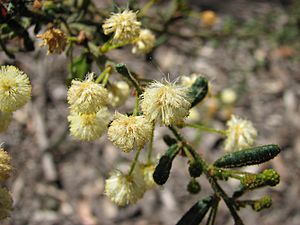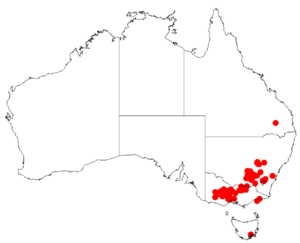Rough wattle
Quick facts for kids Rough wattle |
|
|---|---|
 |
|
| Acacia aspera subsp. parviceps in Brisbane Ranges National Park, Victoria | |
| Scientific classification | |
| Genus: |
Acacia
|
| Species: |
aspera
|
 |
|
| Occurrence data from AVH | |
| Synonyms | |
|
|
The Rough Wattle (Acacia aspera) is a type of spreading shrub. It is special because it is endemic to south-eastern Australia. This means it naturally grows only in that part of the world.
This wattle can grow up to 2 metres (about 6.5 feet) tall. It has unique leaf-like structures called phyllodes. These phyllodes are usually 10 to 30 millimetres long and 2 to 4 millimetres wide.
In winter, from July to September, the plant produces beautiful pale yellow to gold flowers. These flowers are round, like little balls. They grow either alone or in small groups where the phyllodes join the stem. After the flowers, the plant forms curved or coiled seed pods. These pods are 20 to 70 millimetres long and 3 to 5 millimetres wide.
Contents
Rough Wattle: A Spreading Australian Shrub
The Rough Wattle is a fascinating plant. It is known for its tough, rough texture, which gives it its common name. This shrub plays an important role in its native Australian environment.
What Does Rough Wattle Look Like?
The Rough Wattle is a medium-sized shrub. It has many branches that spread out. Its "leaves" are actually phyllodes. These are flattened leaf stems that look and act like leaves. They help the plant survive in dry conditions.
The flowers are a highlight of the Rough Wattle. They are bright and cheerful, ranging from pale yellow to a rich gold. These small, round flowerheads add a splash of color to the Australian bush. They appear during the cooler months.
After flowering, the plant develops its seed pods. These pods protect the seeds inside. Their curved or coiled shape makes them easy to spot. Once ripe, they split open to release the seeds.
Where Does Rough Wattle Grow?
The Rough Wattle is found in specific areas of Australia. It grows from the Grampians in Victoria all the way eastward to the Warby Ranges. In New South Wales, it can be found from Yass northward to Peak Hill.
This plant prefers certain types of soil. You will often find it growing in sandy or gravelly soils. It thrives in open forest areas. It also grows well in mallee communities. Mallee is a type of bushland with many small, multi-stemmed trees.
Different Types of Rough Wattle
Scientists have identified two main types, or subspecies, of Rough Wattle. These subspecies are slightly different from each other. They show how plants can adapt to different local conditions.
- A. aspera subsp. aspera: This is the original type of Rough Wattle. It has bright golden yellow flowers. Its flower stems, called peduncles, are usually up to 10 millimetres long.
- A. aspera subsp. parviceps: This subspecies was identified more recently in 2004. It is found in the Brisbane Ranges and near Beaufort in Victoria. It generally has longer peduncles, from 7 to 15 millimetres. Its flowers are usually cream to pale yellow, not as golden.
How Was Rough Wattle Discovered?
The Rough Wattle was first officially described in 1838. An English botanist named John Lindley gave it its scientific name. He wrote about it in his book, Three Expeditions into the interior of Eastern Australia.
Lindley's description was based on plants collected during an expedition. This trip was led by Thomas Mitchell in 1836. The plants were found near what is now Swan Hill in Victoria.
Rough Wattle Hybrids
Sometimes, different plant species can cross-breed. This creates a new plant called a hybrid. There have been reports of hybrids between Acacia aspera and another wattle, Acacia montana. These have been seen in the Bendigo Whipstick region.

